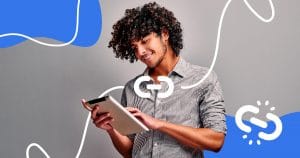At some point in your marketing career you will need to write a marketing email to promote material or sell a product.
You will spend hours writing the best text and the most striking subject. Send the email and…nothing happens.
Incidentally, it may happen that the email is flagged as SPAM by dozens (or hundreds) of contacts, damaging the credibility of your domain.
The fact is that even a well-written marketing email is no guarantee of conversion.
It’s challenging to get people to open email marketing content, and even harder for them to click on a link.
But there is a way to engage your contacts: hyper-personalization.
Hyper-personalization consists of using data from your subscribers to create highly customized experiences. This tactic allows a user to feel that a particular communication was made especially for them, since the email brings what they need or want at that moment.
And contrary to what one might think, 83% of people are willing to share personal information for a more personalized experience.
This data is from State of Marketing 2023, a report created by HubSpot, in partnership with Rock Content, Litmus and Wistia. Throughout this text I will bring other interesting information from the research.
But delivering a hyper-personalized experience is easier said than done. After all, how to communicate with a large number of people in an automated and customized way, at the same time?
In this article, I’ll show you some steps to apply hyper-personalization to your email marketing campaigns.Spoiler: even Artificial Intelligence can help.
The difference between personalization and hyper-personalization
Personalization consists of using basic data to get closer to the user. Information previously provided by subscriber or collected by the company, such as first name and email address, for example.
Hyper-personalization, on the other hand, goes far beyond demographics.It’s about using behavioral information to provide an even more customized experience for each user.It’s as if that email was written just for that person, based on their interests and needs.
This can be done using different channels and tools, such as machine learning, geolocation, Big Data and even Artificial intelligence.
Let’s look at two practical examples of emails sent by a fictitious sporting goods store.
Here’s a possible personalized email:
Hey, {First name}! All good?
In the past you bought from our website. We want to be part of your healthy lifestyle, so we’re offering a 15% discount on selected sports products.
The voucher is valid for our e-commerce or physical stores.
Now an example of a hyper-personalized email:
Hey, {First name}! All good?
In the last few days you bought the {UltraAir 2000 Shoes}. What did you think of this product?
We want to be your partner for a healthier life, that’s why we offer you a super gift: 15% discount on our entire line of {clothing for running and walking}.
Which of these examples would make you feel like the email was sent just for you?
While not a practice to abandon, including just the recipient’s first name is a basic personalization. As the second example shows, it is possible to include more specific information (in this case, the last product purchased) so that the communication is even closer to your audience.
Remember: by knowing your user well, you can offer experiences that make more sense to them.
The issue of data privacy
By using hyper-personalization we enter a sensitive field: personal data sharing. We live in a context of changes to guarantee the privacy of Internet users, and the data strategy of companies must follow this trend.
Google, for example, should disable the third-party cookies in Chrome by 2024. This means that it will not be possible to access user behavior and preference information with open data providers.
This change is worrying when 85% of marketers say their marketing activities depend somewhat or wholly on third-party cookies. In addition, 45% believe that the suspension of third-party cookies will impact this year’s marketing planning.
And this is just one of the many changes that make up a new digital landscape with the Law General Data Protection Regulation (GDPR).
The question that remains is how to create personalized content experiences and still respect data privacy?
54% of respondents are working with alternative solutions, such as first-party data, data provided by the user directly to the company. Other bets are target ads on social networks, Google’s Topics API and contextual or targeted ads.
In email marketing (and any digital marketing tactic, in fact), you need to know how much and what information you use in your campaigns.
If in doubt, avoid invasive approaches: know how to use the data you have to create campaigns that generate identification and engagement without making the user feel watched.
How to Create Personalized Experiences in Email Marketing with Hyper-Personalization
Set a plan and segment your audience
It all starts with good planning. It is counterproductive to do research and use state-of-the-art technologies to collect data but not know what to do with it.
So, here comes a fundamental rule:there is no hyper-personalization without segmentation.
Before writing your marketing emails, make sure you have a segmentation that makes sense.
You can create segmentations based on demographic variables (age, location, educational level) and more specific categories related to customer journey (last product purchased or time spent on a given page, for example).
There is no rule for segmenting email contacts: you must consider a series of factors according to the objectives of your campaigns, such as the purchase journey, the CRM that your company uses, the metrics that will be used to evaluate results, among others.
If you need to start a segmentation from scratch, my tip is to start with the simplest path: define two or three segmentations and, over time, expand this range with more specific and complex divisions.
Collect and analyze data relevant to your goals
People may be willing to provide personal data to have a differentiated experience, but that does not mean collecting any and all information. Why ask if a user has children if that won’t be useful for personalizing your emails, for example?
And here comes what I already mentioned about exaggerating the hyper-personalization data and “scaring” the user, who may feel invaded.
That’s why solid planning and segmentations are critical so you know what data will matter to your email communications.
Use technology to your advantage
At the beginning of this article I mentioned some technologies that can be used to collect data and create hyper-personalized campaigns.
Of course, it all depends on how much budget you have available to invest and what your campaign objectives are.
Big Data, for example, allows you to collect and manage data on a large scale. With Machine Learning, you can gain insights about your users from predictive analytics.
Even Artificial Intelligence can be an ally in hyper-personalization by using data collected in real time and providing valuable information to communicate more individually with each contact.
If none of these tools are an option, you can use forms on your blog or sales pages to collect information. Or, who knows, even with occasional surveys with your subscribers in email campaigns.
Check out how to use Artificial Intelligence in Content Marketing ➝
Create emails with accessibility
Accessibility is also a way to create personalized experiences, and companies have realized the importance of this: 77% of brands are already making their emails more accessible, according to the State of Marketing 2023.
Creating accessible emails is simpler than it looks. Some text and design best practices are a good starting point:
- use short and objective sentences;
- avoid jargon or expressions specific to a region;
- create a design with color and font size hierarchies;
- avoid high contrast;
- use fonts with at least 14px;
- avoid emails with just images and no text.
Learn more about hyper-personalization with the State of Marketing Report 2023
You can see that it is quite a differential to use hyper-personalization to engage your contacts, right?
With due care regarding data privacy, it allows you to bring your brand communication even closer to the real interests of your audience. The consequence of this is engagement and brand awareness, pillars of a good relationship with your target audience and the starting point to gain results with digital tactics.
How about learning more about delivering dynamic content experiences to your audience? In the State of Marketing 2023 we present more insights from the survey of more than 1,200 marketers from around the world. Check out!
Do you want to continue to be updated with Marketing best practices? I strongly suggest that you subscribe to The Beat, Rock Content’s interactive newsletter. We cover all the trends that matter in the Digital Marketing landscape. See you there!







